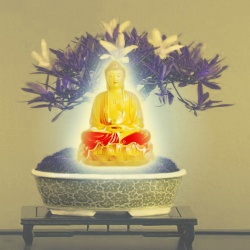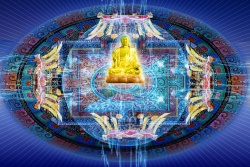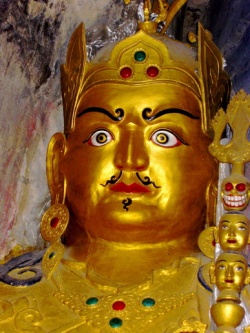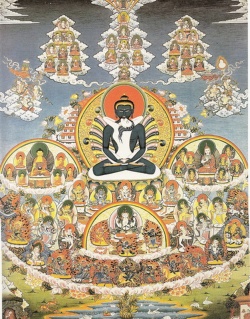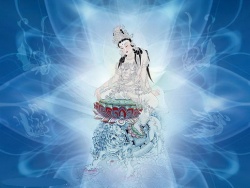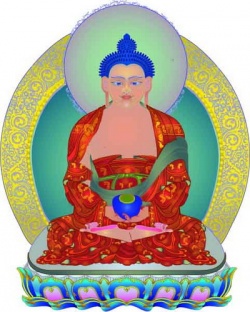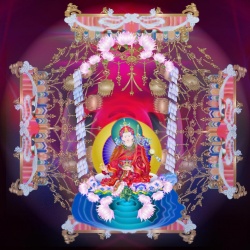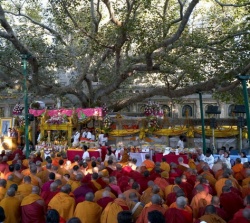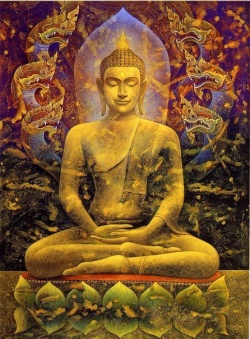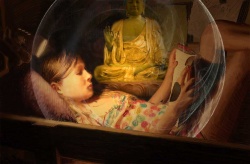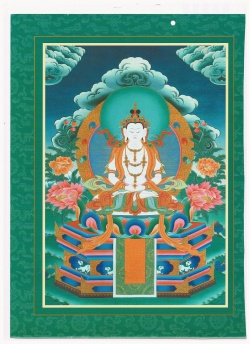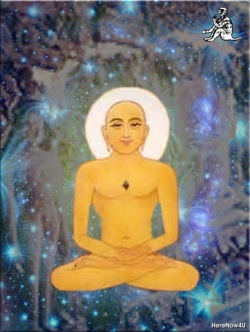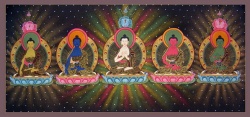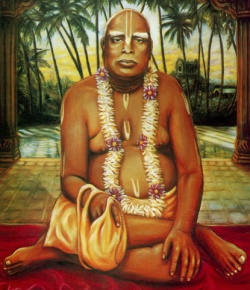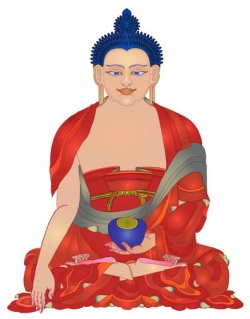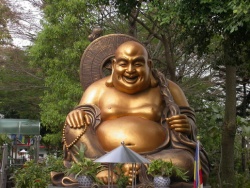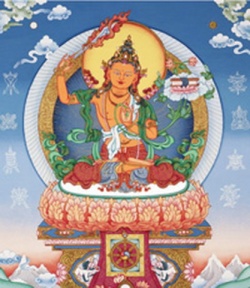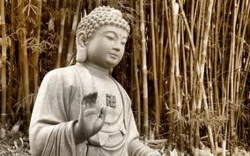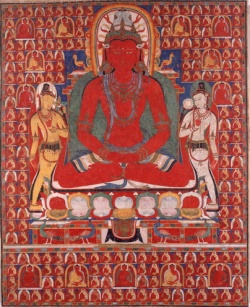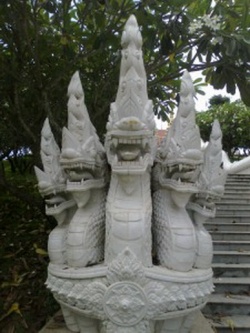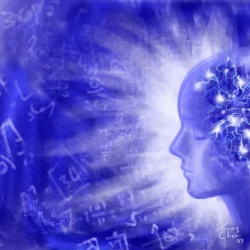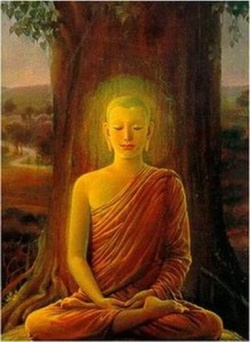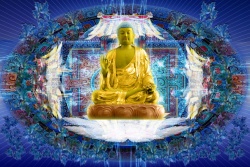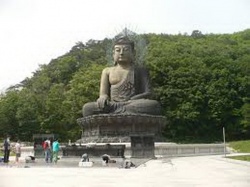The Four Logical Arguments
It is said that there are sentient beings as far as space extends, and wherever there are sentient beings, karmic formations and conflicting emotions also exist.
But the nature of these does not transcend misery.
In order to establish sentient beings, which have such natures, in a state of happiness and to eliminate misery, one should involve oneself in the practice of Dharma.
If the motivation is highly extensive and intensive, then also the result will be extensive and intensive.
The practice and reflection of Dharma should, therefore, be preceded by the altruistic mind or, in other words, the attitude of bodhicitta.
Generally, sentient beings possess what is known as the conceptual mind that fixates on the existence or non-existence of things. From our fixation on the notion of existence evolves many different views and conceptual elaborations.
For example, certain spiritual traditions claim that the earth was created by God, and certain non-Buddhist traditions claim that the world was created by the Supreme Self.
But the Buddha says that the world is not created by a Supreme Self or a Supreme Being, but by the law of interconnectedness, the law of interdependency.
Therefore, the Lord Buddha gave his first sermon as the Four Noble Truths.
Most of his audience, like most of the sentient beings, have a strong tendency to fixate on the notion of existence.
The Four Noble Truths, therefore, reveal the law of karmic causation, which shows that there exists a cause and there exists a result. Causations can be samsaric, or nirvanic.
In samsaric causations, the Buddha presented the cause and result of samsara. In the nirvanic causations, the Buddha presented the cause and result of nirvana.
In order to avert the notion that fixates on existence—the existence or non-existence of everything—the Buddha gave the second sermon, which is an extensive teaching on emptiness.
His third sermon, on the tathagatagarba, also rejected the idea of fixating on existence and revealed that the creator of everything is the sugatagarba, or Buddha-nature.
In this third sermon he said that the root of all phenomenal appearances and experience can be traced back to one’s mind.
If the mind thinks in a right manner, then everything seems to unfold in a good way.
Conversely, if the mind thinks in a mistaken manner, it seems that many things go wrong.
Good and bad things, or negative or positive, therefore, cannot be established merely with regard to external existence. Similarly, positive and negative cannot be established, as far as the Buddha-nature is concerned.
If good and bad cannot be established with regard to external phenomena or the internal existence of one’s mind or Buddha-nature, then where do good and bad exist?
The root of all these things can be traced back to a lack of knowledge.
In the teaching of Dzogchen, it is stated that the nature of mind itself is Buddha-nature, that the mind itself is Buddha.
Whether it is the smaller vehicle or the large vehicle of mahayana or the vajrayana, of all the teachings the Buddha gave during the presentations of these various vehicles, the main force is said to be one’s own mind.
Because of this, one can say that Buddhism is the science of mind.
As Buddhist practitioners, then, we should try to attain certainty that the mind is the creator of both samsaric and nirvanic experience.
At the moment, sentient beings experience four confused, or wrong, views and, because of this, are said to experience the miseries of samsara.
The first wrong view is to fixate on something being clean. The second is to fixate on the notion of happiness. The third is to fixate on permanence.
The fourth is to fixate on self. In these ways, we tend to fixate onto our own physical existence as being clean, permanent, and happy and with an existing self.
As far as the truth is concerned, the skandhas (Sanskrit), the collection of our psycho-physical existence, form, feeling, perceptions, will and consciousness, are impermanent.
When sentient beings are not able to perceive the impermanent nature of their psycho-physical existence, they will fail to realize their impermanent nature as a whole.
But if they utilized the sword of wisdom and dissect the psycho-physical existence, they would be able to reveal the truth, which is that the skandhas are impermanent.
When we investigate our psycho-physical aggregates, it will be revealed that this body and mind, the spirit and matter of our existence, is a composition of many particles and sub-particles, atoms and sub-atoms, not some kind of solid lump.
From the perspective of gross appearance, we say that there exists a person if all five limbs are present.
But if we remove some of the limbs from the person—the arms, for example—and place them somewhere away from that person, then these separate limbs will not be called a person.
Therefore, the body is only a collection of parts.
From the perspective of the base of the composition, this base is said to be a conglomeration of atoms and sub-atoms.
Preceding this base of atomic particles is the level of the atomic energy that gives rise to the subsequent unfolding of the particles.
Therefore, even the subtlest level of atomic particles cannot be said to be the creator of the world, and the atomic particles cannot be claimed to be permanent.
As soon as the subtlest particles appear, they vanish or transform into something else and so are not permanent.
Therefore, from the perspective of one’s psycho-physical existence as a whole, one can understand that one’s skandhas do not remain constant; they go through constant changes because the building blocks of the skandhas go through constant changes.
If you analyze the skandhas by applying your wisdom and intelligence in this way, and if you further analyze this gross body in terms of subtle body, this subtle body will be understood in terms of subtle impermanence.
This understanding of impermanence will evolve into understanding of emptiness. If one meditates in this manner, this is said to be a true meditation as mindfulness of one’s own body.
What is the significance of understanding impermanence? Understanding the impermanent nature of things will allow us to avert our attachment to our experiences, and we will be able to enjoy a non-attached state of mind.
Realizing impermanence will also allow us to further develop practicing wholesome deeds and to stop indulging in negative actions.
In the same way, the understanding of impermanence can give rise to certainty of and a longing for liberation.
When we genuinely long towards the attainment of liberation, it will be possible to attain ultimate happiness.
In many of the sutras, the Buddha said that, among all the footprints, the elephant makes the biggest, and among all the meditations, the meditation of impermanence is said to be the greatest.
It is therefore important initially to exert oneself in meditation on impermanence. External phenomenal appearance undergoes constant change; in the same way, our own body also goes through a constant change.
If our minds are not able to move in parallel with the external movement and change of our body, we will experience misery.
Realization of impermanence will remove the fear we normally experience.
For example, it will remove the exhaustion we can experience in spiritual practice, the suffering that occurs when we experience something unexpected, and the suffering that comes from seeking something and not finding it.
Thus, the mediation on impermanence has the power to lessen the impact of all of these different miseries.
Suffering will come, momentarily or for a period of time, but then it will go away. In the same way, happiness comes, remains for a while, then vanishes—all because of the law of impermanence.
Therefore, there is not much point in worrying about the beginning of suffering or the end of happiness because the law of impermanence will touch both experiences.
The Buddha said that, if we do not understand the fourfold knowledge of the impermanent nature of our skandhas, suffering, emptiness and selflessness, then we will experience misery; if we do understand this, we will experience happiness.
Buddha formulated many rules, not simply to restrict us from doing certain things, but protect us from certain things. For example, the restriction against monks living with women, not because women are evil of nature, but in order to secure the mind of the practitioner from disturbing emotions.
The same applies to intake of alcohol: Alcohol is not wrong in itself, but the restriction is formulated in order to stop our addictions.
In certain cases, however, it might be useful to perform seemingly negative actions.
If one performs one of the seven negative actions pertaining to one’s body or speech, and the action is associated with the Dharma and there is a compassionate motivation for performing it, then one is not completely restricted from doing it.
The Buddha has not said that all external and internal phenomena are suffering.
But when we do not understand the nature of these phenomena, such a lack of knowledge will be a cause of misery.
Hence, one should understand that the root of the teaching of the Buddha lies in understanding the law of interdependent origination. One should equally understand impermanence;
that is, the fact that everything is empty and without self.
When these things are understood in their proper context, then all outer and inner experiences become nirvanic experience, the experience of happiness.
But when we fail to understand their nature, they become the suffering of samsara. It is therefore essential for a practitioner to become well versed and learned in the law of interconnectedness, emptiness, selflessness and so forth.
I would now like to reveal the four wrong views: the fixations on cleanliness, happiness, permanence, and self.
The antidote to these four wrong views or attitudes is meditation on dirtiness, suffering, impermanence, and selflessness and emptiness.
When we fixate on our skandhas to be something very clean and blissful, or to be permanent or to have a self, we generate a tremendous amount of attachment which can lead to the development of many complications.
To realize the impermanent and suffering nature of our skandhas, we must meditate on the meaning of emptiness and selflessness.
At the moment, we are explaining the suffering nature.
Everything is not in the nature of suffering, but when we do not understand the impermanence, the emptiness, and the lack of self with regard to outer and inner phenomenal experiences, then everything becomes suffering.
So if one were to explain that everything is misery, that everything—all outer and inner phenomenal experience—has a suffering nature, then one is making a false statement. Such statements are traditionally said to be criticism and fabrication.
By now, the impermanence and suffering nature should be properly understood as the nature of the relative truth, so the nature of the relative truth should be understood. On the other hand,
emptiness and selflessness are the law of the ultimate truth and, when we enter into the practice of the Dharma, it is important to acquire certainty with regard to such views, primarily through studying and reflecting on the Dharma.
The practice of Dharma is, therefore, not something that should be studied outwardly, but something that should penetrate one’s heart or mind.
There is a saying that, if Dharma is practiced as it should be, instead of lifting us to further heights of wisdom, we will actually descend. According to the legend, it is said that Devadatta,
the nephew of the Buddha, was extremely learned in the Dharma, but the knowledge had not penetrated into his heart.
Therefore he was reborn as a preta, a hungry ghost.
In contrast, the Tibetan yogi, Milarepa, was not that well versed or very learned in academic Buddhism, but he became completely enlightened.
His teacher, Marpa, gave instructions as pith instructions (concise instructions), and Milarepa meditated very enthusiastically on these and attained enlightenment.
So, even if you are not very well versed in the whole spectrum of Buddhism, you will be able to familiarize yourself with the four antidotes that will avert the wrong view: the meditations on dirtiness, emptiness and selflessness, impermanence, and suffering. That will be sufficient.
We live within the world of impermanence, experiencing it constantly, so failing to realize the impermanent nature of ourselves and others will cause suffering.
As an example, if you are in very deep water and you don’t know how to swim, you will be in trouble.
The impermanence can be compared to the body of water, and the knowledge of impermanence can be compared to swimming.
Swimming in impermanence, as we all do, is dangerous if one does not have the knowledge of impermanence.
Today, the weather is very warm and nice; therefore, this example of swimming came about. Laughter.
We are still talking about the suffering nature, and while we are talking about this nature, I would like to mention two equal terms, subtle impermanence and all-pervasive suffering.
These two terms mean the same thing because they point towards the same experience. You might have heard or will hear the term “all-pervasive suffering” mentioned.
If you genuinely understand the meaning of impermanence in this life, you will realize that there isn’t anything big that you can acquire or lose. You will become free from the hope of both acquiring something and losing something.
Understanding the nature of the relative truth requires understanding of impermanence and, also, understanding impermanence is said to be very essential even with regard to understanding the nature of the ultimate truth, emptiness and selflessness.
Understanding of the relative truth in terms of impermanence and suffering is a stepping stone that will allow us to understand the nature of the ultimate truth.
Because of this, the Indian master, Chandrakirti, said, “Relative truth is the method, whereas the ultimate truth is the result of that method.”
He said that, if you do not understand these two things, you will be entering a wrong path. It is like a bird that jumps from a cliff without two wings will fall to earth and die.
Due to the lack of knowledge about the nature of the relative and the ultimate truth, the individual will go through the turmoil of samsara, whereas the individuals possessing the knowledge of relative
and ultimate truth can be compared to a bird having two wings being capable of flying wherever it wishes, up and down, because it has complete freedom in the totality of space.
Through this example, we understand that we shall try to equip ourselves with the two wings of understanding, both relative and ultimate truth.
With such skills, we will be capable of flying through space.
By acquiring certainty with regard to the relative and ultimate truth, it is possible to meditate on emptiness, which is said to be like the vast expanse of space.
But if we lack this certainty, even if we were to meditate, and our meditation generates pain in our butts and our knees, it will be no more than self-torture. Therefore, the attainment of the certainty with regards to these views is essential.
What do we mean when we say “view”? The view is something that is decided by our thoughts or concepts.
The teaching on impermanence, emptiness, suffering nature, and selflessness was thought by the Buddha on the basis of his own certainty.
Buddha based his teachings on the certainty he gained, and we should also examine whether meditation on such teachings will bring about spiritual benefit or not.
The fourth antidote is said to be the understanding of emptiness. Generally, when we talk about emptiness in this context, it should be understood as emptiness of phenomena.
It implies that all phenomenal appearance is not single; it means there is no singularity as far as the phenomenal experience is concerned.
Also, the term “emptiness” implies that phenomenal appearance or experience relies on other factors, meaning that they are interconnected. The term “emptiness” also implies an assembly of many causes and conditions.
To recapture and establish a line of argument, phenomena are not established on the basis of singularity, because the phenomena depend on multitudes of other factors.
Because the phenomenal appearances or experiences depend on other factors, they are of an interdependent origination, and because of the law of interdependent origination, phenomena are said to be empty.
The emptiness of the phenomena implies the interconnectedness of the phenomena.
For example, the emptiness of the space accommodates mountains—the external environment—as well as the sentient beings within that environment. Space functions to accommodate all these things.
Therefore, emptiness accommodates the possibility of interdependent origination.
Because of emptiness, the phenomenon that occurs from interdependency comes about in the beginning, remains, and finally disappears.
Many teachers have worked towards establishing emptiness, like Nagarjuna, Aryadeva and others.
Since time without beginning, up to this present point, our mind has been habituated in terms of fixating onto the true existence of things. In order to avert such fixation, we need to exert effort in terms of meditating on emptiness.
For example, our confusion has become so solid that even phenomenal experiences like dreams are taken to be true while we are dreaming.
In order to lessen our clinging onto true existence, many logical arguments were developed by the ancient masters of India.
And even though there are many logical arguments which should be studied and reflected upon, they can all be summed up in the Four Logical Arguments.
The first logical argument is examining the cause. It is called the vajra (Sanskrit, meaning "thunderbolt") argument. Of course, vajra is based on a certain mythology. The vajra argument is able to challenge all wrong views and concepts.
The first argument is therefore called the vajra argument.
Question: You used the word “singularity.” I don’t think I understand what you imply by the word singularity.
It seems that it means that they don’t exist by themselves, but as a result of many causes and conditions coming together.
Emptiness implies non-singularity because no phenomena can be singular because many causes and conditions need to come together for the phenomena to appear, and if one does not exist then many will not exist either.
So the understanding of emptiness transcends singularity and plurality. According to the view, it is said that, while phenomena are empty, there is at the same time appearance.
You see, sentient beings generally attach to appearance, but in the nyingma view, this appearance is established as emptiness on the spot.
Person: On the spot?
Lama Changchub: What Rinpoche was saying is that we tend to generate attachment with regard to the appearance, right?
And in order to avert the attachment to things, emptiness is established on the spot with regard to that appearance. Emptiness is revealed in the very moment something appears; one does not to reveal emptiness aside from the appearance.
Rinpoche: Now, do you feel like realizing emptiness? You look like a great meditator.
Before we meditate, we should use our conceptual mind to think.
The reason is simply because we possess this mind, and this mind is capable of thinking.
When we think about these subjects and gain certainty, then the thinking mind will simply drop on its own. Dropping the thinking mind and gaining certainty is termed “acquiring the wisdom mind.”
Certain spiritual traditions say the Buddha experiences both purity and impurity.
They say the Buddha is omniscient, and therefore the Buddha must experience impurity as well as purity.
But such statements are wrong. The reason is because, when we abandon this physical human existence, we are not able to experience the humanness.
When we leave our present physical existence and acquire a new physical existence, for example that of an ant, our experience of possessing a human body is completely gone.
In this new body of an ant, we will not have the slightest trace of the experience of the human body, because we are completely enveloped by the new experience of the ant.
It is therefore said that the Buddha knows what impurity is and what purity is. But the Buddha does not experience these; they do not present themselves in front of him; they are only known to him.
For example, in order to train sentient beings, the Buddha sometimes talks about many precious jewels and articles within the pure lands.
But, in fact, there may be no such jewels in those pure lands.
The point is that we are fond of precious jewels, that we are attached to them, so Buddha uses our liking of the jewels and says that if you cultivate the ten virtues actions, you will be able to acquire these precious jewels and you will be borne in certain pure lands.
But it is questionable when you are borne there, whether you are truly able to acquire such jewels, but certainly you are able to acquire the precious jewel of Dharma. Do you have more questions?
Question: Can Rinpoche explain more about subtle impermanence?
Subtle impermanence is said to be difficult to realize and understand for common people.
This is because it is very subtle. For example, the gross changes of a child becoming a youth, and the youth becoming a grown up come about because of the subtle changes that occur within the mind stream of that individual.
The subtle impermanence cannot be seen by our eyes.
For example, as soon as a plant sprouts, it goes through change, but this is difficult to perceive with the gross sense organs of our eyes.
But if you placed a video camera in front of the small sprout, then you would be able to see the changes.
Or you can sit in front of the plant until it grows big; then you will se all the changes that occur. But it is easier to use a camera. Laughter.
The Buddha has said that the experience of common people is like the palm of the hand.
The experience of noble people, of realized beings, is like the experience of the eye.
He further said that, if you place a strand of hair in the palm of your hand, you are not able to feel anything. But if you place that single hair on your eye, then immediately you will feel uncomfortable.
Because noble beings have realized subtle permanence in this manner, they do not develop attachment to their body, not to mention other phenomena.
But ordinary sentient beings, not having realized the subtle impermanence, develop attachments and difficulties of letting go of things and so forth.
For example, you might fixate on the same Khenpo Sangpo that came to Norway four years ago and today. Actually I have gone though a tremendous change.
But I also perceive Reidun (a person in the room) in the same way, but my perception could be wrong.
Question: Is the realization of emptiness one of the main conditions for achieving wisdom mind?
The realization of emptiness is the attainment of the wisdom itself, because realization of emptiness corresponds to the reality of the phenomena. You are realizing the truth of the phenomena as it is.
Question: How should one realize emptiness?
One of the methods is to realize impermanence on its various levels, including the subtle level. Understanding of the gross form of impermanence is quite easy. One should use this understanding as a stepping stone to understand the subtle nature of impermanence. This will lead to the understanding of emptiness.
It can be compared to the construction of an airplane. In the beginning, somebody discovered the knowledge of how to build a machine that could fly.
At that time, the knowledge was rather gross, but using that as base, it has been refined and airplanes have become more and more sophisticated. In a similar way, using the understanding as a base, one should move slowly to understand more and more of the subtle reality.
Initially, our meditation should take into consideration the grosser aspect of the reality, such as impermanence and so forth. Then, gradually, we should try to enter into more subtle levels of impermanence, and then finally into emptiness.
It is a little bit like all the numbers can be constructed from zero. Zero can be said to be the mother of all numbers.
But the zero in itself is nothing. So similarly, the base of all phenomenal experiences is emptiness, but emptiness in itself is nothing.
Question: So, when one meditates, can one meditate on a table or a brick stone or some other object?
You can select one object and then try to establish the emptiness of that object.
When you do this, the same emptiness can be applied with regard to all other phenomenal appearances as well.
It is said to be like when you cut one bamboo and you realize the emptiness of the bamboo, you will understand that all other bamboos in the world also has this empty, hollow quality.
Buddhist texts talk about the 16 different types of emptiness, but as far as the truth of the emptiness itself is concerned, you cannot divide the truth of emptiness into 16 types.
This division is made on the basis on the objective phenomenal existence.
Take, for example, 16 different sizes of vases placed in the midst of space; you are talking about 16 types of emptiness, not from the perspective of emptiness itself, but from the perspective of the different-sized vases.
The main thing is to look within oneself and then try to establish the emptiness of one’s skandhas, the psycho-physical aggregates.
This is the most important.
Question: Is that what you sometimes call selflessness?
When you realize emptiness of the self, this is the realization of selflessness.
There is a term that says “the body simply vanishes into atomic particles.” In other words, it means disappearing into a rainbow body. This happens because the person realizes the emptiness of the skandhas.
Our mind has created a diversity of phenomenal appearances and experiences in terms of big, small, good, bad, and everything in between and so forth.
When we realize that the creator of all the diversity of these phenomena appearances and experiences is merely our own mind, then this single realization allows us to make everything vanish.
The compassionate lord Buddha Shakyamuni has revealed us many different levels of teachings. Among all the teachings that he has given, if you know how to take the essence of his teachings in terms of instructions and implement these, this would be the best.
Whether we are involved with listening to teachings or reflecting and meditating upon what we have heard, it is essential to precede such phases of practice by the altruistic mind of bodhicitta.
Having thus generated the altruistic mind of bodhicitta, the teachings that we are trying to study and meditate upon can be termed dharma.
If we want to find the essence of the Buddha’s teachings, we should understand the fourfold knowledge of impermanence, the suffering nature, emptiness and selflessness.
If we implement this knowledge in our practice, this would constitute the essential instruction for practice.
During the previous session, we finished talking about the subjects of impermanence and the suffering nature.
The law of impermanence and the suffering nature are the characteristics of the relative truth.
One should also understand the division of impermanence in terms of the grosser level of impermanence and the subtle level of impermanence.
One will realize the subtle form of impermanence by understanding the grosser form of impermanence.
For example, the very fact that there is smoke above a hill signifies that there must be fire somewhere behind that hill.
Mere understanding will not allow us to ultimately eradicate the root of misery. In the beginning, it is crucial to gain understanding of the different levels of impermanence. Based on this knowledge, one should try to attain the actual realization of the grosser and subtle form of impermanence.
Mere intellectual understanding of the various forms of impermanence will allow us to suppress the conflicting emotions, whereas the actual realization of the various levels of impermanence will allow us to eradicate the very root of the conflicting emotions.
What we need to eliminate from our mind stream is our fixation on the notion of the four wrong views: fixation on the notion of purity, fixation on the notion of happiness, and fixating onto the notion of permanence and self. These four wrong views should be abandoned.
But how do we generate these wrong views? We generate them on the basis of our psycho-physical aggregates, or the five skandhas.
In brief, it can be said to be grasping onto our spirit and matter.
Most individuals claim that I am pure or that I am beautiful; very few will claim that I am impure and I am ugly.
And most individuals, while actually being submersed in the midst of suffering, will still feel that they are enjoying happiness.
This is the reason these individuals are not willing to separate themselves from the worldly existence of samsara. Because of our grasping onto matter and spirit, we cultivate the notion of a truly existing self.
In the same way, the notion of one, or singularity, and the notion of permanence without having to depend on others come about.
And, yet again, in the same way, we develop the notion of self being the owner of the five aggregates, and develop grasping onto these aggregates.
Based on these various causes, we hold onto the notion of ourselves being supreme while others are inferior, and on the basis of this polarity, we tend to generate the conflicting emotions of hatred, jealousy and other forms of negative emotions.
Also, if we fixate onto the notion of not having to depend on others, then motivation for generating love and compassion for others will not arise.
If we were to look at the reality of matter and spirit from the ultimate perspective, then the question of purity and impurity does not apply at all.
Hence, happiness and unhappiness does not exist with regard to matter and spirit.
In the same way, matter and spirit eludes permanence and impermanence as well as self and others. In other words, they transcend permanent and impermanent, and beyond self and others as well.
Nevertheless, beginners on the path should try to understand the reality of matter and spirit in terms of suffering and impermanence.
Why should they do that? Because understanding of impermanence will gradually give rise to an understanding of emptiness.
If you, for example, were to realize the impermanence of my hand, or your own hand for that matter, due to the hand being the composition of many atoms and sub atoms, and that on the atomic level the hand is going through a constant change, you would be able to attain certainty of the emptiness of the hand.
Also, the hand seems to be single, but it eludes singleness because there are five fingers joined together. Similarly, there does not exist a single finger, because the finger is also a composite of joints and many other particles, and if you were to further dissect the atoms, you will arrive at the partless particles.
These particles are not static, but dynamic because they go through a constant change. The most subtle level of atomic particle is not static for even a moment.
The followers of the shravakayana are able to realize the emptiness of personal self because they are able to analyze down to the most subtle level of the partless particle, but they hold onto the notion that these partless particles are static,
that they do not go through change. Even with such a partial understanding, they are able to attain the realization of the emptiness of the personal self.
But as far as the realization of the emptiness of the phenomenal self is concerned, they are not able to realize it;
they realize only the emptiness of the personal self based on their arguments that bring them to the partless particles, holding that these are static, whereas the followers of the mahayana realize the impermanent nature of even these partless particles, and such an understanding leads to the realization of the emptiness of the phenomenal self.
For example, in order to change the grosser aspect of reality, the scientist will delve into the level of the sub-particles that acts as building blocks for the grosser reality, and will try to do something at this level in order to produce a measurable result on the grosser level.
Similarly, by relying on the sword of wisdom, we should try to dissect the reality to arrive at the level of the most subtle particles, and then, when one arrives at this level, these particles should be realized to be emptiness.
To understand emptiness, one needs to understand the mode of emptiness, the manner by which emptiness exists.
If one fails to understand the proper mode by which emptiness exists, and still persists in meditating on emptiness, then such a meditation can be termed shamatha. It is not meditation of vipashyana.
Shamatha meditation will allow us to temporarily suppress the conflicting emotions, but will not remove the conflicting emotion completely.
For example, when we undertake the samadhi, or practice that pertains to the four formless god realms, we begin by conceptualizing that all phenomenal appearances and experiences are equal to space.
Similarly, all phenomenal experiences and appearances are thought of as equal to consciousness, without any tangible form.
Further, one meditates on the concepts that all phenomenal appearances and existence do not exist at all. One thinks in terms of neither existence nor non-existence.
These are the four samadhis that are cultivated in connection with the four formless god realms.
But these four types of meditation are worldly meditations that will not bring the meditator beyond the worldly realm.
Instead, when we cultivate emptiness as a pure view, or the antidote to avert the four wrong views, we are not talking about the seeming emptiness as meditation, as it pertains to the four formless god realms.
Here, when we talk about emptiness, it should be understood that the phenomena are empty in themselves.
There have been created many logical arguments to establish a genuine understanding of emptiness, but all these arguments can be summed up as the four logical arguments.
It is quite difficult to understand these logical arguments, and actually it comes down to the question whether you are familiar with this manner of analysis or not.
If you are familiar, it will be easy to grasp their meaning; if not, it will be difficult. When one has understood the different levels of the logical arguments, one should apply this knowledge in one’s meditation practice.
The purpose of meditation practice is to familiarize oneself. But it is not necessary to meditate on permanence.
Also, it is not necessary to meditate on self. This is because we are already very familiar with the idea of something being permanent and something having a self.
Since I entered the Buddhist academic institutes in Tibet, I have heard many lectures on impermanence, selflessness and emptiness. Because of hearing this and the practice that I put it to, occasionally there would arise a certain understanding.
A mere understanding of the classification of reality is not effective in terms of equalizing suffering and happiness, or of equalizing self and others.
Only by putting into practice what one has understood on the intellectual level will one attain the equalization of self and others, and purity and impurity and so forth.
To start with, to be able to understand the empty nature of the things, one should familiarize oneself with the understanding of the four great arguments and attain certainty on the basis of that.
Then one puts it into practice.
Most of us conceive that matter and spirit come into being at some beginning, remain for a while, and then disintegrate at the end.
One should try to establish the reality of the unborn by relying on the practice and understanding of the four great logical arguments.
If one can do so, one can remove suffering. So we are trying to establish the unborn state.
The first logical argument is the vajra prongs that analyze the cause.
Why is one required to meditate on the first argument? Because usually we believe that all phenomena arise because of certain causes.
And from the perspective of the individual who has not undertaken the practice of analysis, it seems to be so: that certain phenomena come from certain causes.
But if we were to profoundly scrutinize the reality, we would attain the realization of the unborn state.
If something is born as a result of a certain cause, then the birth of that phenomena must occur from itself or it must come from something else, “from other.”
The other options are that the birth of the phenomena comes from both self and other, or that the birth comes from the absence of self and others. These are called the four extremes.
One cannot find another manner of birth than these four extremes.
When we talk about a certain phenomena being born from itself, no individual will be ready to accept such a proposition. For example, one can not claim that the father is born from the father himself.
The example of the father is used in order to establish that self is not born from itself or that certain phenomena are born from the particular phenomena themselves.
If the father is born from the father himself, then the initial birth of that father becomes meaningless, because the father is born twice.
Question: But the definition of a father is that somebody else is born, so that the father is born as a father.
For example, you cannot say that I am born from myself. If it were so, the initial birth becomes meaningless. If the initial birth is meaningless, then the subsequent birth also becomes meaningless.
This logical argument should be applied to all classifications of the reality. If self were to be born from itself, then there comes about two faults:
The birth becomes meaningless and the birth becomes ceaseless. Not only one birth becomes meaningless, but hundreds of subsequent births become meaningless as well.
Actually, this logical argument is actually rather sharp. If one is not able to grasp it, one should try to think about it, and you will grasp the meaning.
Meditating in this manner will allow you to refute the notion of fixating onto the self. Particularly, it refutes the notion of holding onto a self that is permanent, like some non-Buddhist schools propose.
If the self would be permanent, then a static phenomenon could not perform any function, as opposed to a dynamic phenomenon.
If a function is being carried out, then that very performance implies impermanence.
Now, we have refuted the first extreme, the birth of self from itself.
We shall try to refute the birth that occurs from others, as for example, the birth of a son from a father.
If something is born from other, then there comes the fault of the birth of light from darkness. Examples of these are the birth of misery from the performance of virtuous acts, and the birth of happiness from the performance of negative actions.
Another example is a man giving birth to a child, as only women can do this. The main point is that all this falls into the category of birth from other.
If the phenomena are not born from self and neither born from others, then it will be easy to deny the third extreme that proposes that phenomena are born from self and others.
When we were investigating the first logical argument of the vajra prongs, we were primarily analyzing the cause of the phenomena. During the second logical argument, we are primarily investigating the result of the phenomena in terms of existence and non-existence.
Question: What are the relationships between the logical arguments and the four extremes?
In the analysis of the first logical argument, one primarily analyzes the first two extremes. When one understands the two first, it is easy to understand the third and fourth.
The purpose of the logical argument is to prove that birth does not happen from any of the four extremes.
We shall now examine the second logical argument in terms of existence and non-existence. We shall examine the characteristics of matter and spirit.
Matter and spirit will be either cause, result or essence. For example, the pear in my hand is either cause, result or essence.
By establishing the cause, the result or the essence of a certain phenomenon, we tend to fixate on these. By the first argument that analyzes the cause, we established the emptiness of that cause, or the non-characteristics of that cause.
By the second logical argument, one tries to establish that the result is free from desire.
If there is a result, we usually aspire to attain that result. And by this argument we try to cut through the desire that aspires to attain that result.
The third logical argument is the argument of being neither one nor many.
The first three logical arguments are sometimes called the three doors of liberation. The fourth logical argument is said to be the king of all logical arguments and is the logical argument of interdependent origination.
Let us suppose that we vaguely understand what is meant by analyzing the cause through the first logical argument. Let us go back and delve a little deeper into the second logical argument of analyzing existence and non-existence, or production and cessation.
If a result is born from a cause, does that result truly exist or does it not exist?
If the newly formed result was said to exist prior to its birth, it becomes meaningless to give birth to a new existence.
Conversely, the cause cannot give birth to something that does not exist, because than there would be nothing.
It would not be very meaningful to say that something that is non-existent has been born. In that case a lotus flower could be born in the midst of space.
It follows that all non-existent things would come into existence by following this line of reasoning. Do you understand?
Question: Is this where one talks about the hair of the tortoise?
Yes, and the horn of the rabbit. Both are examples of things that do not exist.
If a result is being born by relying on the cause, what kind of result is born? Is it non-existent or existent? Do you understand the question?
Question: Is this where we say neither, and you go on refuting this also?
If the answer is that the result is non-existent, then it follows that it will be a possible to find hair on a tortoise and horn on a rabbit.
Because through this kind of logic we would be able to make everything that is non-existent become existent. You are welcome to analyze it, examine it, and comment on it.
The main thing is that we usually experience many discursive thoughts and conflicting emotions, and that one meditates on the logical arguments in order to lessen the impact of these thoughts and emotions.
The meditation works by challenging our discursive thoughts and emotions.
Sometimes the audience will ask the teacher how one should proceed with one’s meditation. Should one meditate on analytical or concentrative meditation? To answer, one must prepare with some analytical meditation; otherwise there is actually nothing to concentrate on.
When we talk about performing analytical meditation, we are not talking about analyzing how to subdue our enemy, how to win a victory over the enemy, or how to accumulate wealth and so forth.
If we focus on this, it can seem like it is analytical meditation, but it lacks the true meaning of true meditation. For example, the leopard walks very quietly when hunting.
Its intention is to capture the prey and devour it. The real nature of the leopard can be very non-peaceful. A mere adoption of physical postures does not imply a peaceful nature of an individual.
We try to attack the enemy that holds onto the notion of a truly existing self, as well as the conflicting emotions, by using the arrow of the logical arguments. So try to grasp and be mindful of the logical arguments.
The third logical argument is termed neither being one or many. Generally, we perceive the skandhas, matter and spirit, as being truly existent. In order to avert such wrong views, we contemplate on the third argument.
If such phenomena exist, they exist either in terms of one or many.
The phenomena do not exist in terms of one, and the body does not exist in terms of one single lump. In the same way, we can analyze the spirit or the mind.
The mind does not exist in terms of one lump, because from birth up to this point, how many conceptual minds, thoughts and attitudes have we not generated in our mind?
All these patterns constitute our mind, and there is no single entity that exists within the mind or the body.
Now, forget about the time from birth up to this point; just look from one month ago up to this moment, or one week up to this time, or from yesterday up to this moment.
The number of discursive thoughts and conflicting emotions that we have generated are limitless. All this constitutes our mind.
If “one” cannot be established, then naturally “many” cannot be established as well.
The forth logical argument is the argument of interdependent origination, or interdependent connectedness.
According to this logical argument, all phenomena are shown to be interdependent-originated; therefore, phenomena are said to not be truly existent.
This presentation is unique to Buddhism and is not shared by other spiritual traditions.
Hence, the logical argument of interdependent origination is said to be the king of all logical arguments, and there is no phenomenal experience that lies beyond the law of interdependent origination.
The great logical argument of interdependent origination analyzes the cause of the phenomena, the result of the phenomena, and the essence of the phenomena.
If you have not heard this before, it is rather difficult to comprehend.
But if you grasp the meaning of these logical arguments, then it will be easy for you to actually meditate on the true meaning of emptiness.
If you realize the view of these logical arguments, you will not find a more superior view than this, even within the presentation of Mahamudra or Dzogchen.
Therefore Lama Mipham said, “In order to truly realize the meaning of the primordial purity, one needs to understand the meaning of the presentation of the Prasangika-Madhyamika.”
You are welcome to ask questions concerning the four logical arguments.
Question: Can you please give an example of the fourth logical argument?
Rinpoche strikes the bell sharply with the vajra
The sound that is produced comes from striking the bell with the vajra.
Therefore, the sound is interdependent on the vajra, so the sound is the result of many causes and conditions coming together.
Its actual nature is emptiness. That is the reason the bell is rung quite often: to teach you interdependent origination. Rinpoche jokes.
Question: But does this not show that something can arise from something that is different than itself? Certainly the sound is different from the vajra.
It seems like the sound is born from something else other than the sound, but that is just how it seems.
If you delve deeper into this seeming reality, you will arrive at the fact that the sound is not born from other.
For example, in that case, say, if the vajra were placed as it is, without being used to strike the bell, then the vajra is the other, right? Then the vajra should be able to produce the sound by itself.
Question: But cannot happiness be born from suffering?
Well, then, in the same way, one must conclude that suffering is born from happiness. In the process of trying to establish emptiness, there is a risk involved, and the risk is that one can do away with karmic causations. This is very serious.
In his Entering the Middle Way, Chandrakirti objects to the meditator meditating on the emptiness of the karmic law of cause and result.
When the meditator focuses his meditation on emptiness with regard to the law of karmic causations, this form of meditation can cause the practitioner to disregard karmic law; therefore, the author objects to the meditator to meditate on the emptiness of the law of causation.
In the beginning, we tried to establish emptiness through negatives, using terms as “non-existence” and so forth.
This negative emptiness can be further analyzed in tögal (Tibetan), a state completely free from any form of elaboration.
But if the negative emptiness remains, there is a risk that one falls into the pitfall of nihilism, where nothing exists and there is no meaning.
In order to prevent the meditator from falling into the nihilistic state, one should establish the negative emptiness into tögal.
Like Shantideva said, “When the meditator becomes familiar with emptiness, the meditator will cast away his familiarity with materialistic clinging to the solidity of the phenomena.”
He further stated that he had “familiarized with nothing whatsoever,” meaning leaving even the familiarization of emptiness behind.
In the Uttaratantrashastra, the author says that even the dharma or the sangha are not the ultimate object of refuge. In this treatise, the path is compared with a boat.
When the path is traversed—when the boat has been used to cross the river and one has arrived safely on the other shore—the boat can be left behind; you don’t need it anymore.
Having realized emptiness, there is no point in holding onto the notion of emptiness, because one simply leaves behind the realization of emptiness.
But to realize emptiness, one needs to attain the realization of the meaning of emptiness.
But if we claim that we are meditating on a state that is free from fixation, it actually becomes very difficult to meditate and sustain such a state, because even the claim that “I am meditating without fixations” is a subtle fixation in itself.
In the beginning, one usually meditates with a certain amount of fixation, and then, gradually, one leaves the fixations behind and enters into a state free from fixation.
As long as we possess a belly, we need to eat because we get hungry. Similarly, we have to think in terms of conceptual thoughts and fixations because we have a mind.
But when we talk about cultivating fixations in meditation, we are not talking about cultivating negative fixations; we are talking about cultivating positive fixations in the initial state of one’s meditation.
Positive conceptual thoughts or states of mind are compared with a very fertile ground, on the basis that on this fertile ground one can reap a very prosperous crop.
But cultivation of negative thoughts and emotions can be compared with an infertile ground, making it impossible to give rise to a prosperous crop.
By basing the cultivation on wholesome or positive thoughts and emotions, there is a possibility to give rise to the wisdom that knows the nature of the reality.
On the other hand, the possibility of generating the wisdom that knows the reality as it is by relying on negative thoughts and emotions is nil.
Hence, it is important to attempt to cultivate a noble mind or heart.
Generally, when we understand emptiness, it becomes rather easy to understand what we mean by selflessness. Emptiness tries to establish the emptiness of the phenomenal self, whereas selflessness tries to establish the emptiness of the personal self.
Therefore, selflessness should be understood in terms of cultivating the emptiness of the personal self.
For example, if you mistake a statue for a real person at a distance, then as you get closer, you will realize the suchness of the statue to be a statue, and the mistaken idea will disappear.
If we, by examining the body and mind, understand the emptiness of the person, this is said to be the realizing selflessness, the realization of the emptiness of the personal self.
I will stop here. Maybe your bladder is full.
This is a common problem during the teaching sessions in Tibet.
When I used to attain the teachings of certain khenpos, these khenpos would be a little inconsiderate and continue their teachings for several, maybe three hours.
Question: If you understand selflessness and the fact that things are not truly existent, like we have been going through—if you have a good understanding of this, if you have a very full bladder and a lot of pain, how will that remove the suffering of the bladder? (laughter)
That means you haven’t understood the true meaning of emptiness and selflessness. (Everybody is laughing.)
If you were truly able to understand the true meaning of emptiness, not only understanding it, but also realizing it, then the fullness of the bladder will not be a problem.
In East Tibet, in the early stage of the Chinese occupation, one Tibetan boastfully claimed that he had realized the profound meaning of emptiness.
From now on, he would not be harmed by anything. When a Chinese leader heard of this, he had the man tied to a post and shot him in his hand. Of course, the bullet pierced the hand, and the man began to scream. Finally, the man was killed.
In reality, he had not understood the meaning of emptiness; he had simply proclaimed it. During those days, the Communists were very hostile towards religious proclamations like this.
Question: The shravakayanas are able to realize the emptiness or the absence of self by reducing the self to partless particles, but why are they not able to use this argument to realize the inherent emptiness of the phenomena?
The fundamental reason is because the followers of the shravakayanas are fearful of realizing the emptiness of the phenomenal self.
This fundamental fear prevents them from fully realizing the emptiness of the phenomenal self.
Question: What is the difference in realizing the emptiness of the self and the emptiness of the phenomena?
Mipham Rinpoche gave a very good example of this; if there is a rope lying in a very dark room, and a person happens to enter the room, the rope can be mistaken for a snake. This is confusion.
The mistake can be eliminated by lighting a lamp and realizing the absence of the snake in the rope. This liberates the person from the fear of encountering a snake.
But the person has not realized the suchness of the rope itself. The rope is not realized to be empty of true existence.
Followers of the shravakayana analyze the body-mind phenomena to its most subtle level and attain the realization of the emptiness of the personal self.
The reason they are able to realize the emptiness of the phenomenal self is because they have arrived at the subtlest level of particle, that of the permanent partless particle.
But they fixate onto their notion of this, and because of this, they are not able to move further.
This is the reason they are not able to realize the emptiness of the phenomenal self.
Question: Why do they believe that these particles are permanent?
Does it not say in the sutras that everything is impermanent?
This is because one single teaching of the Buddha is being interpreted on many different levels.
Also, the speech from one single person can be heard in many different ways.
For example, what I have taught today could be understood in many different ways by many different people.
Question: Does everything come from the mind? It has to start somewhere or we would not have to do all these things.
When you say where all these things are coming from, do you mean all the dharmas or what I spoke about?
Same person: I mean everything, it has to start somewhere.
All things come from emptiness. Your thoughts also come from emptiness. Your very thought is emptiness.
Question: Is this Madyamika?
Yes.
All the explanations that I have given to you are based on my personal understanding of the scriptures.
Question: How would you meditate on selflessness?
To meditate on selflessness, first one has to establish the selflessness by analytical meditation.
For example, if you want to meditate on the selflessness on the phenomena, the emptiness of the self of the phenomena, then you need to go through the different phases of these four great arguments.
You have to conduct analytical meditation, the medium of these four great arguments.
And you should analyze the meaning of the selflessness of the phenomena until you gain profound certainty with regard to selflessness of the phenomena.
Once you gain profound certainty, you should stop further analysis and let your mind rest within that certainty.
The presentation of the four logical arguments is like a handle that you can hold onto while trying to establish the selflessness of phenomena, but this does not mean that you should not use your intelligent mind to analyze the selflessness of the phenomena.
If we can come up with our own version of logical arguments in order to establish and validate the selflessness of phenomena, we are welcome to do so.
We should also alternate our meditation with the sutra tradition of the Buddha and the tantric presentation of the Buddha.
According to the sutra tradition of the Buddha, we analyze and experiment, but according to the tantric tradition, we primarily allow our mind to rest within the state of certainty.
Question: Can you recommend a book on the four logical arguments?
You will find the presentation of the four logical arguments in the books known as Entering into the Middle Way by Chandrakirti, and The Root Verses of the Middle Way by Nagarjuna.
Among many of the treatises on this subject, these two are considered most important.
So we will stop here and conclude with the prayers.
Translated by Lama Changchub at [[Karma Tashi Ling Buddhist Centre[[, Norway

